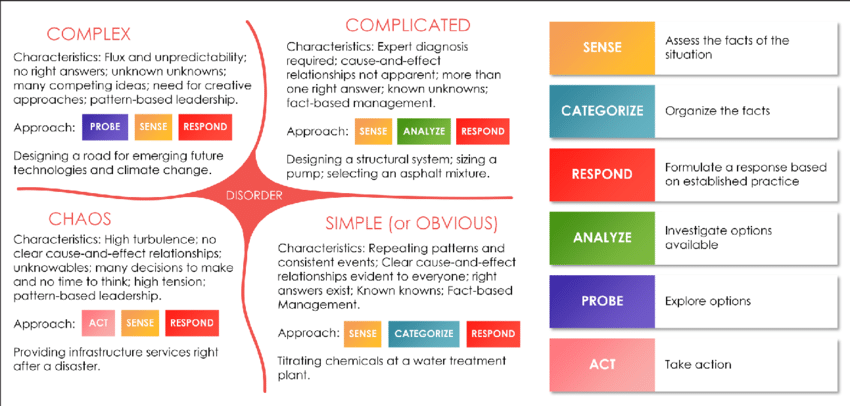thinking tool.
The one about making sense of problems
Snowden’s Cynefin Framework
Credit: David Snowden BA MBA (1954-)
Summary:
The Cynefin Framework is a problem solving tool that helps determine the necessary actions to begin to solve a problem. The five domains of the framework are ‘clear’ (simple and obvious) contexts, ‘complicated’ contexts, ‘complex’ contexts, ‘chaotic’ contexts, and ‘confusion’ (disorder or unknown context). See graphic below for the location of the domains relative to each other. In short, the domains on the right are ‘ordered’, meaning cause and effect is known or can be discovered. The domains on the left are ‘unordered’, meaning cause and effect can only be deduced in hindsight or not at all. When a problem is considered from its relative domain the framework provides advice on how to approach solving the problem. For problems in the ‘clear’ domain the advice is ‘sense-categorise-respond’. For ‘complicated’ problems the recommended approach is ‘sense-analyse-respond’. For ‘complex’ problems it is ‘probe-sense-respond’. And for ‘chaotic’ contexts it is ‘act-sense-respond’.
Real world application:
Clear represents the “known knowns”. This domain applies when all the variables involved are well known. Generally there are rules in place and best practice can be identified. Decision making here requires ‘reason’ to search for the rule and apply it. In this situation use sense to list everything that is needed, categorise all factors involved, and respond by following the procedure to obtain the optimal result. An example is the mass production of sand bags used to protect property in a flood. All the equipment, materials, and best practice process is known, then applied to produced the optimal product over and over again. This is the domain of best practice.
Complicated represents challenges where most of the variables are well known, and the goal is known but how to achieve it is not known – at least not immediately. In this situation use sense to list everything that is needed, analyse how to maximise the results, and respond by following the selected process (one of many) to get a good result (often through repeated attempts). An example is the way an electrician might seek to identify the cause of an electrical circuit tripping continuously in a family home. All the relevant components of the system are identified, the relevant electrical circuit is isolated and analysed, and then several theories are tested to identify the part of the system responsible. This is the domain of good practice.
Complex represents the “unknown unknowns”; where there are no right answers. This domain applies in situations where it is difficult to make predictions about the future because there are many variables present, and many uncertain factors could intervene. In this situation use probe to identify what has proven to work in similar situations in the past, use sense to inform a plan, and then respond, reviewing and repeating the cycle. An example is responding to vandalism in a small community. Leaders may seek to identify what other communities have attempted in the past, develop a plan tailored to their community and available resources, trial the plan, and review, repeating the cycle several times, knowing that the act of responding will change the situation in unpredictable ways. This is the domain of emergent responses.
Chaotic represents situations where events are too confusing or fluid for a knowledge-based respond, and where cause and effect are unclear. In this situation act first to establish order, use sense to identify where stability lies, and respond again to turn the situation into a complex or complicated situation. An example is the collapse of a grandstand full of people at a sports ground. After calling emergency services, the initial actions would include ushering people to safety, removing some debris if it is safe to do so, and then sensing what the situation presents, such as, delivering first aid to injured people, coordinating assistance of others to lift heavy debris. This is the domain of novel responses.
Confusion represents the centre of the framework and applies when there is no clarity about which of the other domains apply. An example might be a Board of governance of a community organisation needs to respond in a leadership and public relations crisis. It may be helpful to breakdown the situation into its distinctive parts and assign each part to their respective domains, thereby creating manageable problems that can be responded to in contextually appropriate ways. In this example, the ‘clear’ domain might support the application of appropriate industrial rules for the standing down of the leader and the appointment of an interim leader; while the ‘complicated’ domain guides the communication to staff and affected customers; while the ‘complex’ domain might house the public relations response over the short to medium term.


